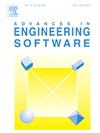一种抑制动态拓扑优化中低密度元素引起的特征频率和特征模态误差的域演化方法
IF 5.7
2区 工程技术
Q2 COMPUTER SCIENCE, INTERDISCIPLINARY APPLICATIONS
引用次数: 0
摘要
在涉及特征频率的动态拓扑优化中,期望直接问题的解能合理地反映实际结构的力学性能。然而,由于在固定的设计域中存在低密度元素,与后处理得到的真实结构相比,总是存在一定的误差。这些误差包括特征频率误差和特征模态误差,它们可能对优化过程产生不利影响。当优化高阶特征频率时,这个问题变得特别明显,其中的误差可能导致解空间中的不连续并阻碍收敛。为了克服这一问题,本文提出了一种领域演化方法(DEM)。该方法将固定设计域划分为三个域:固体域、窄带域和低密度域。直接问题分析在计算域内解决,计算域由实体域和窄带域组成,而低密度域则不活动。算例验证了该方法的有效性。数值结果表明,误差主要出现在寻形过程中,并随着特征频率阶数的增加而增大。该方法有效地减轻了这些误差,保证了优化过程的稳定收敛。此外,通过与传统方法的对比分析表明,在高阶问题中,低密度元素与动态拓扑优化中的经典问题密切相关,包括局部模态、重复特征频率和模式切换现象。这为高阶特征频率拓扑优化的内在困难提供了进一步的见解。本文章由计算机程序翻译,如有差异,请以英文原文为准。
A domain evolution method to suppress the eigenfrequency and eigenmode errors caused by low-density elements in dynamic topology optimization
In dynamic topology optimization involving eigenfrequencies, the solution of the direct problem is expected to reasonably reflect the mechanical performance of the real structure. However, due to the presence of low-density elements in the fixed design domain, there are always some errors compared to the real structure obtained through post-processing. These errors include errors in eigenfrequencies and eigenmodes, which may adversely affect the optimization process. This issue becomes especially pronounced when optimizing higher-order eigenfrequencies, where the errors can lead to discontinuities in the solution space and hinder convergence. To overcome this issue, this paper proposes a domain evolution method (DEM). In this method, the fixed design domain is divided into three domains: the solid domain, the narrow-band, and the low-density domain. The direct problem analysis is solved within the computational domain, which consists of the solid domain and the narrow-band, while the low-density domain remains inactive. Several examples are used to validate the proposed method. Numerical results indicate that the errors primarily arise during the form-finding process and become more significant with increasing order of eigenfrequency. The proposed method effectively mitigates these errors, ensuring stable convergence of the optimization process. Furthermore, a comparative analysis between the proposed method and the traditional approach shows that, in higher-order problems, low-density elements are closely related to classical issues in dynamic topology optimization, including localized modes, repeated eigenfrequencies, and mode switching phenomena. This provides further insight into the intrinsic difficulties of high-order eigenfrequency topology optimization.
求助全文
通过发布文献求助,成功后即可免费获取论文全文。
去求助
来源期刊

Advances in Engineering Software
工程技术-计算机:跨学科应用
CiteScore
7.70
自引率
4.20%
发文量
169
审稿时长
37 days
期刊介绍:
The objective of this journal is to communicate recent and projected advances in computer-based engineering techniques. The fields covered include mechanical, aerospace, civil and environmental engineering, with an emphasis on research and development leading to practical problem-solving.
The scope of the journal includes:
• Innovative computational strategies and numerical algorithms for large-scale engineering problems
• Analysis and simulation techniques and systems
• Model and mesh generation
• Control of the accuracy, stability and efficiency of computational process
• Exploitation of new computing environments (eg distributed hetergeneous and collaborative computing)
• Advanced visualization techniques, virtual environments and prototyping
• Applications of AI, knowledge-based systems, computational intelligence, including fuzzy logic, neural networks and evolutionary computations
• Application of object-oriented technology to engineering problems
• Intelligent human computer interfaces
• Design automation, multidisciplinary design and optimization
• CAD, CAE and integrated process and product development systems
• Quality and reliability.
 求助内容:
求助内容: 应助结果提醒方式:
应助结果提醒方式:


